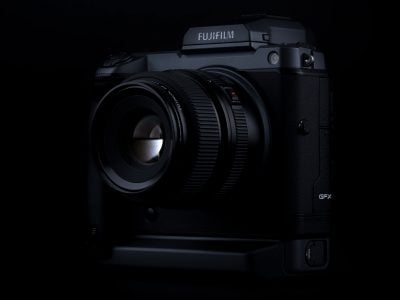Fujifilm GFX 100 review
-
-
Written by Gordon Laing
Intro
The Fujifilm GFX 100 is a medium-format mirrorless camera with 100 Megapixels, built-in stabilisation, phase-detect autofocus and 4k video. Teased at Photokina in September 2018 and officially announced in May 2019, it’s the third model in Fujifilm’s GFX series. The new flagship marks a number of firsts, not just for GFX, but for medium format in general, combining industry-leading resolution with the faster handling and video capabilities of smaller cameras.
The GFX 100 employs what Fujifilm describes as a brand new sensor, sporting 100 Megapixels, double that of the earlier GFX 50S and GFX 50R and delivering images with 11648×8736 pixels. The sensor shares the same 43.8×32.9mm dimensions as the previous bodies, but crucially now employs a back-illuminated CMOS design which should reduce noise, compensating for the higher pixel density. It also becomes the first medium format sensor with embedded phase-detect autofocus, boasting coverage across the entire frame. The autofocus software and algorithms are inherited from the X-T3 and while the GFX lenses are slower than the X series, the GFX 100 still enjoys noticeably quicker focusing than the earlier GFX bodies; it also sports eye-detection.
In another first for GFX and medium format in general, the sensor is stabilised within the body with a 5-axis system claimed to deliver up to 5.5 stops of compensation – ideal for hand-holding the unstabilised lenses in the G system. The GFX 100 also becomes the first medium format system to capture 4k video using the full sensor width without cropping, up to 30p and in 10 bit 4:2:0 internally or 10 bit 4:2:2 externally over HDMI; the flat F-Log is also available as well as the full selection of Film Simulations. Wrapping-up the specifications are a weather and dust-resistant body with a built-in portrait grip, twin battery packs, dual SD slots, twin status LCDs, a tri-axial 3.2in monitor sharing the same articulation as the GFX 50S and X-T3, USB charging and power delivery over USB C, and a new removeable electronic viewfinder with a 5.76 Million dot OLED panel and 0.86x magnification for a large and detailed image.
I’ve now spent a great deal of quality time with the GFX100, first at the launch event in Tokyo, followed by an extended shooting period back in Brighton. I’ve filmed two videos to demonstrate the quality, performance and my experiences. The first provides a hands-on overview of the camera, while the second concentrates on the headline features of quality, focus, stabilisation and video – check them both out for my full review! I’ve also taken some excerpts from the video below for those who prefer a written approach, and of course there’s my sample images, quality comparisons and final verdicts all accessible from the tabs above or the links at the end of each page.
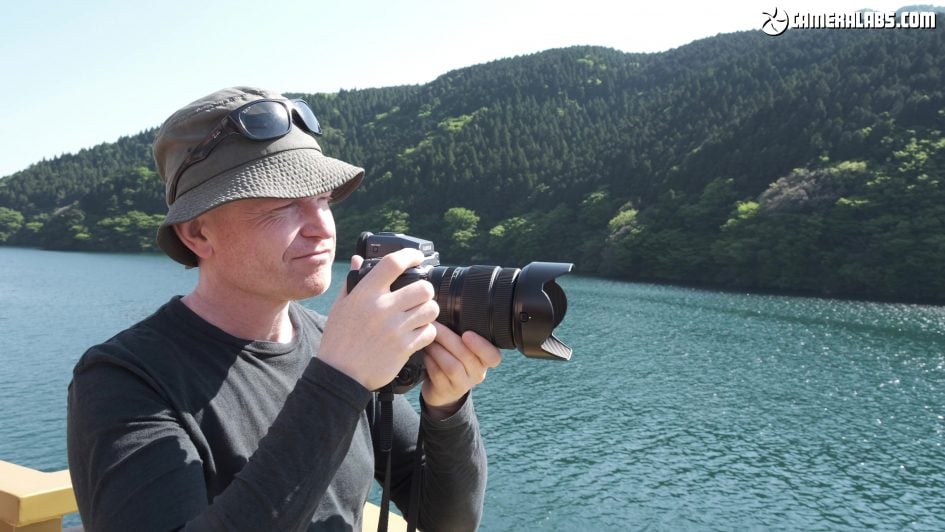
I had a chance to shoot with the GFX 100 in Japan alongside the 50R to see how far the format had evolved; Fujifilm described my sample as being final hardware running not-quite-final firmware, but the quality should be close to production models.
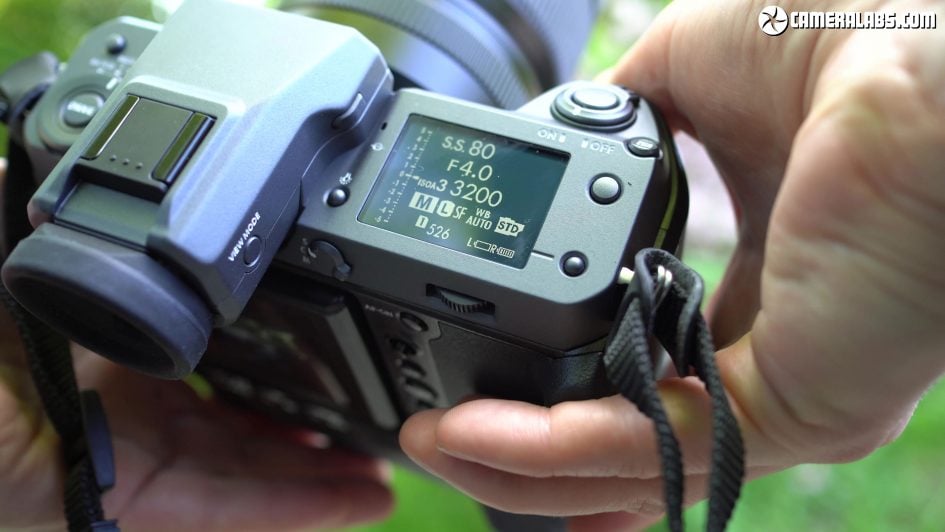
The headline feature of the GFX 100 may be its massive resolution, but for me the most important story is the improved handling and usability. Traditionally when you think of high-resolution medium format photography, you’re locked to a tripod, often tethered in a studio with extensive post processing. The GFX 100 can certainly be used like this if you like, but for the first time, this is a medium format camera you can easily shoot handheld in the field, and thanks to Fujifilm’s processing, the images are very usable straight out of camera.
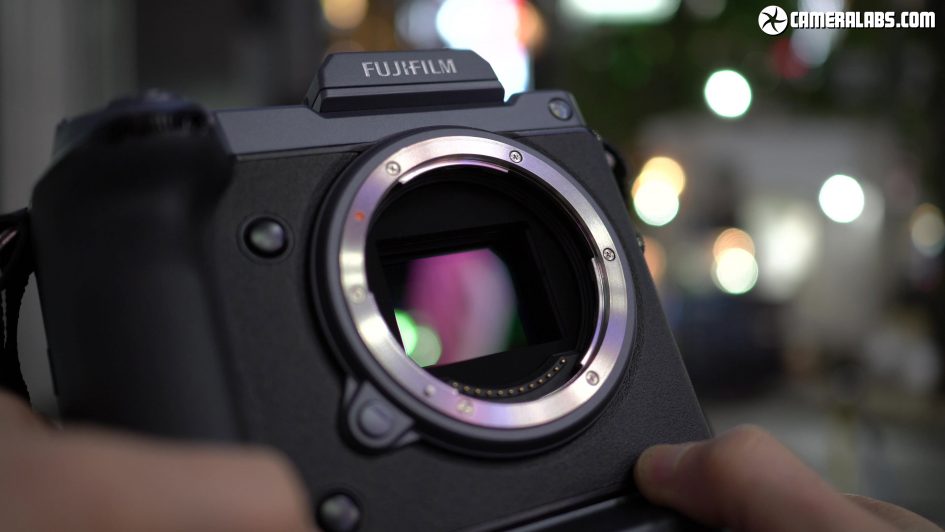
The GFX 100 employs what Fujifilm describes as a brand new sensor, sporting 102 Megapixels, double that of the earlier GFX 50S or 50R and delivering images with a whopping 11,648×8,736 pixels. The sensor shares the same 43.8×32.9mm dimensions as the previous 50 Megapixel version, giving them 1.7 times the area of 35mm full-frame, but crucially now employs a back-illuminated design that reduces noise and should compensate for the higher pixel density. It also becomes the first medium format sensor with embedded phase-detect autofocus, boasting coverage across the entire frame. The autofocus software and algorithms with face and eye detection are inherited from the latest X-T3 firmware and while the GF lenses are slower than the fastest X models, the GFX 100 still enjoys noticeably quicker focusing than the earlier GFX bodies.
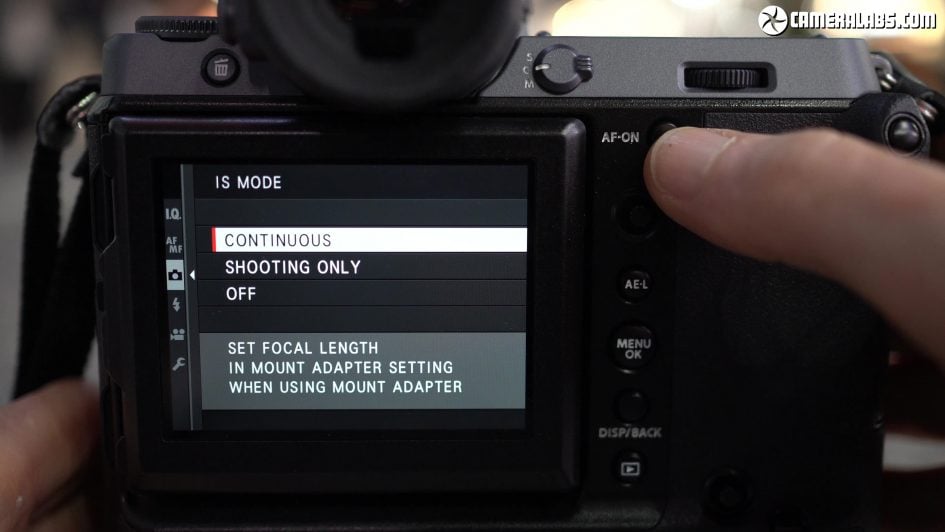
In another first for GFX and medium format in general, the sensor is stabilised within the body with a 5-axis system claiming up to 5.5 stops of compensation. This transforms the usability of unstabilised lenses, although right now GF lenses with optical stabilisation will override rather than work-alongside it as Fujifilm believes they’re already good enough.
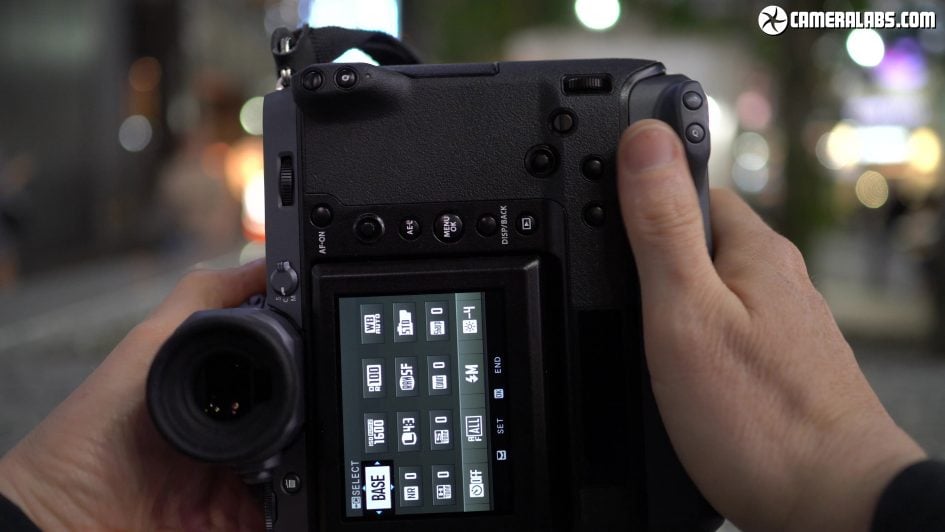
In your hands the GFX 100 is a substantial but by no means unwieldy camera, very similar in size and weight to a Canon EOS 1Dx Mark II or indeed the GFX 50S when that model’s fitted with the battery grip. The GFX 100 is weather-resistant and has a comfortable main grip, and like a pro DSLR, also features an integrated portrait grip with duplicate controls. Interestingly though the vertical grip itself is thinner and smoother than the main grip which leads to a slightly inconsistent handling experience where I also found the thumb joystick harder to reach. I believe having a matching portrait grip would have increased the size and weight, but I’d accept that sacrifice for the consistency offered by the GFX 50S. Fujifilm has historically offered screw-on bases to boost the grips on some models though, so maybe one will come for the GFX 100.
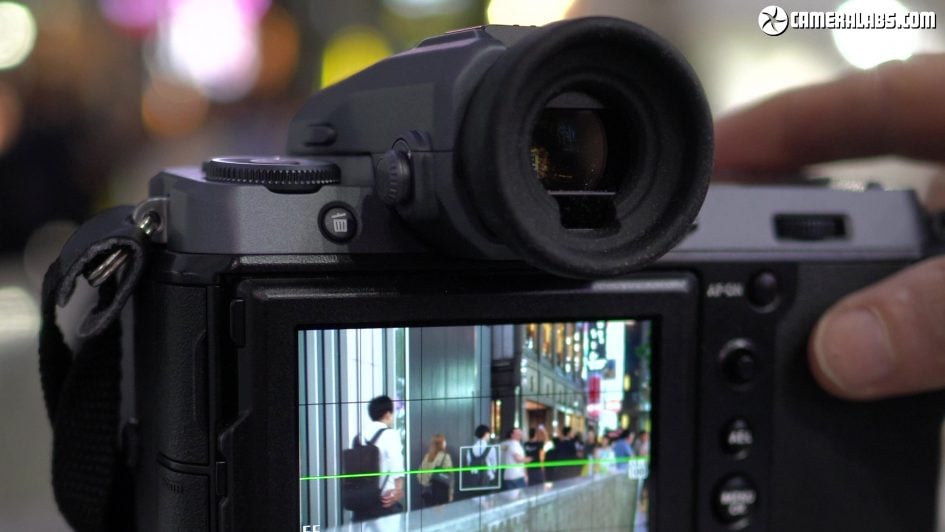
Absolutely no complaints about the viewfinder though which employs a very high resolution 5.76 million dot OLED panel with a huge 0.86x magnification. Panasonic used the same resolution on the S1 bodies and the 1600×1200 viewfinder resolution delivers a visible step-up in detail over 3.69 million dot panels which have 1280×960 pixels. But it’s the size and correction on the GFX 100 which really impresses. It’s easily the most immersive and best quality electronic viewfinder I’ve ever used. It’s also removeable, allowing you to save space or mount it on the optional tilt adapter first seen on the GFX 50S, although sadly 50S owners won’t be able to use the new viewfinder as an upgrade.
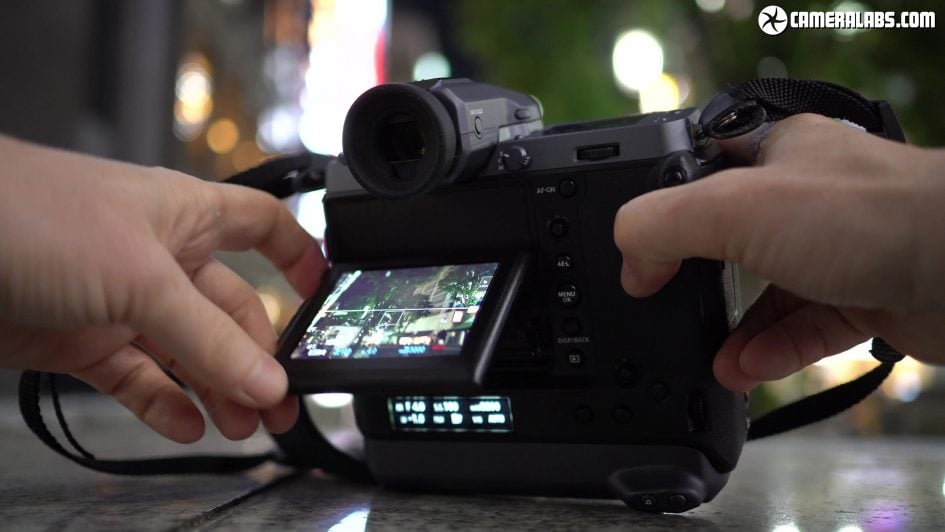
The GFX 100 employs a 3.2in touchscreen that shares the same three-way tilting mount as the GFX 50S and X-T3. You can angle it up by 90 degrees for low-level shooting, although the viewfinder head will obstruct some of the view. You can of course slide off the viewfinder head for a clear view when shooting at waist-level, but I’d have preferred a mount that allowed the screen to be pulled away from the body, making it quicker to shoot discreetly on the street. Moving on, the screen can angle down by 45 degrees for easier composing at high angles, and by pushing a button on the left side you can flip it out sideways, making it easier to compose at low angles in the portrait orientation, and notice how like X-bodies, the shooting info also turns to stay upright. Unsurprisingly it won’t flip to face forward, but I think owners will be perfectly satisfied by the articulation on offer.
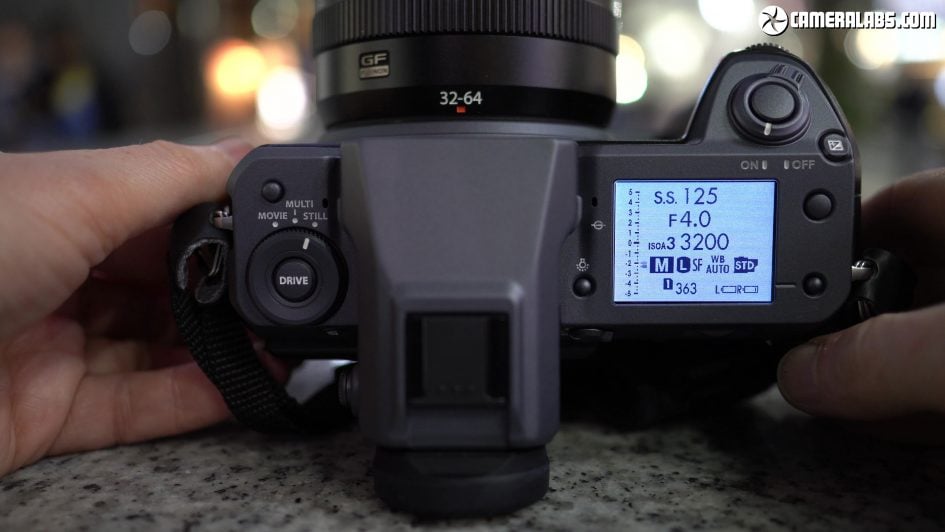
The top surface is notable for the absence of traditional dials and the presence of a generous sub-monitor, which displays the most recent settings when powered-off. Switch-on and it refreshes, while a button lets you reverse the display for easier legibility – notice the wealth of info including icons for both batteries, and I found it easy to view in direct sunlight or dim conditions. Here I have the camera set to Manual with the front dial configured to adjust the shutter speed and the rear dial adjusting the ISO sensitivity, both customisable. The button to the upper right of the screen switches the exposure mode and when set to Aperture Priority lets you turn the lens ring to set the f-number. Setting the lens ring to Auto turns the GFX 100 to Program or Shutter Priority mode, again adjusted by the Mode button.
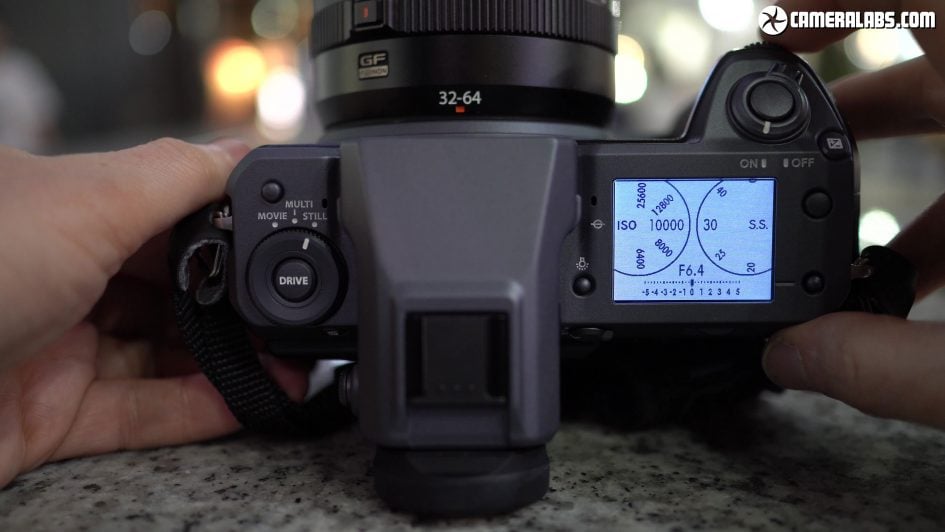
The sub monitor has three pages, cycled using the smaller button to the lower right. The second page displays the function of the control dials graphically for those who miss the old shutter and ISO dials of older Fujifilm bodies. Here I have the shutter speed on the right and the ISO sensitivity on the left, while the exposure compensation runs along the bottom.
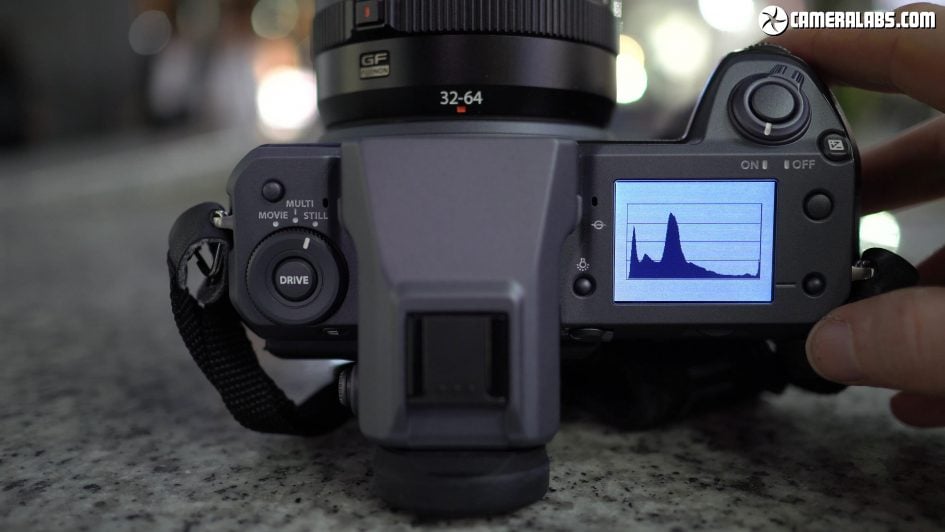
Then the third page devotes the entire 1.8in 303×230 dot LCD screen to displaying a live brightness histogram. I really enjoyed using the upper LCD sub-monitor and quickly got to grips with the new exposure and mode adjustments.
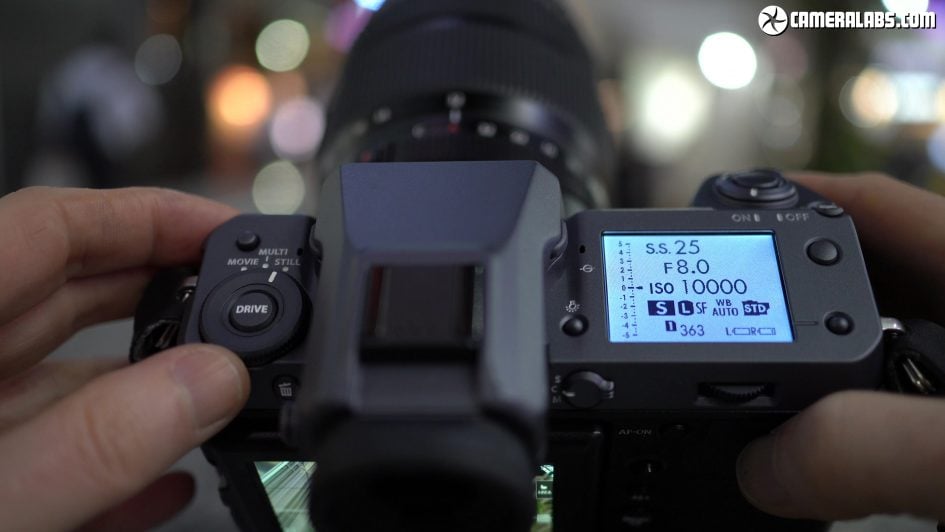
The other side of the main interface is the lockable drive dial on the left which lets you switch between still photos, multi which includes bracketing options, and movie, and notice how the sub monitor screen switches to show the video settings which are completely independent from the still photo settings. Something similar was possible on the X-T3 and X-T30 with the silent movie controls ignoring the physical dials, but separating stills and movies here is even more intuitive. Cleverly the Drive button itself also presents options relevant to the mode, so when set to Still you can choose between single or the two continuous modes, the latter offering up to 5fps or 2fps with live view. Turn the dial to Multi and the Drive button presents all of the bracketing and multiple exposure options, gathered together for neatness. Then turn the dial to Movie and the Drive button presents the video quality page. By presenting relevant options, this approach lets you quickly get to where you need to, and minimises delving into menus.
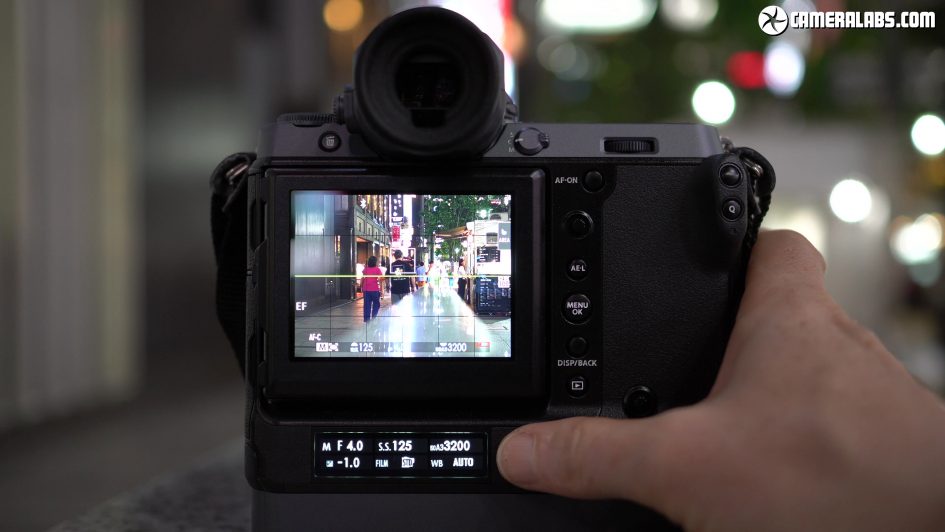
Turning to the rear of the camera you can see the thumb wheel, a small dial for setting the autofocus mode, and an AF joystick. Most of the rear controls seem inherited from the X-bodies though where I already considered them unnecessarily small, and here even more so. There’s loads of space on the rear surface so why not deploy larger buttons, dials and joysticks for easier operation, especially when wearing gloves? And while there is gesture recognition if you want it, I see nothing wrong in also including the traditional cross keys since there’s room. Moving on, under the main screen is the rear sub-monitor, a 2.05in 256×64 dot OLED display showing useful shooting details at a glance. There’s four page options, but unlike the top sub-monitor, no button to cycle through them. Instead you’ll need to dive deep into the menus to find the rear sub-monitor options, which seems a bit inconvenient to me. Hopefully it can be assigned to a custom function with a firmware update. Of the four page options I liked the live histogram view best, but having all the essential shooting information here means the main colour screen becomes freed-up for composition alone if desired.
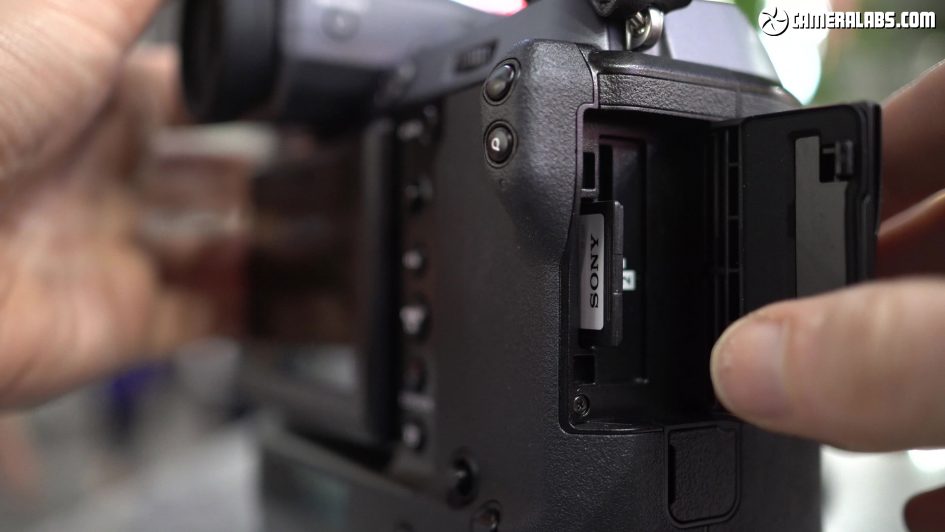
On the right side of the body are twin SD card slots. The huge file sizes could have made an argument for a faster format, but equally SD gives you access to the largest capacities at the cheapest prices. I’m happy with the decision.
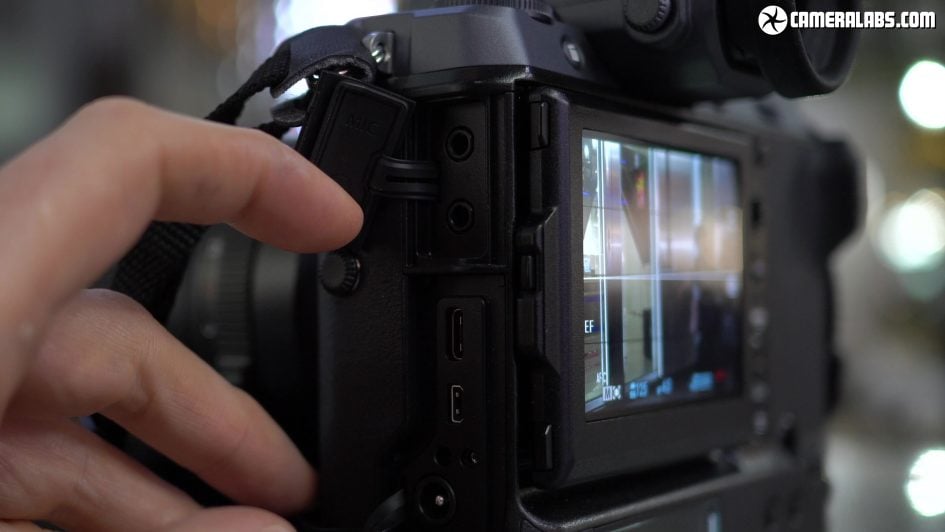
Behind a couple of flaps on the left side are the ports, starting with 3.5mm microphone and headphone jacks at the top. Below these is a USB C port running at 3.2 speeds and I’m delighted to report also able to charge the battery in-camera or power the camera while in operation. Below this is a Micro HDMI port which can output 10 bit 4:2:2, although given the size of the camera surely there’d have been room for a more robust full-size port. And at the bottom there’s a DC input for powering the camera with an optional adapter, although again you can alternatively power it over USB if preferred, and it’ll work with a powerbank. In terms of wireless, there’s Wifi controlled by Bluetooth and like the recent X-bodies you can pair the camera with your phone to seamlessly tag GPS locations as you shoot – I did this for many of my sample images.
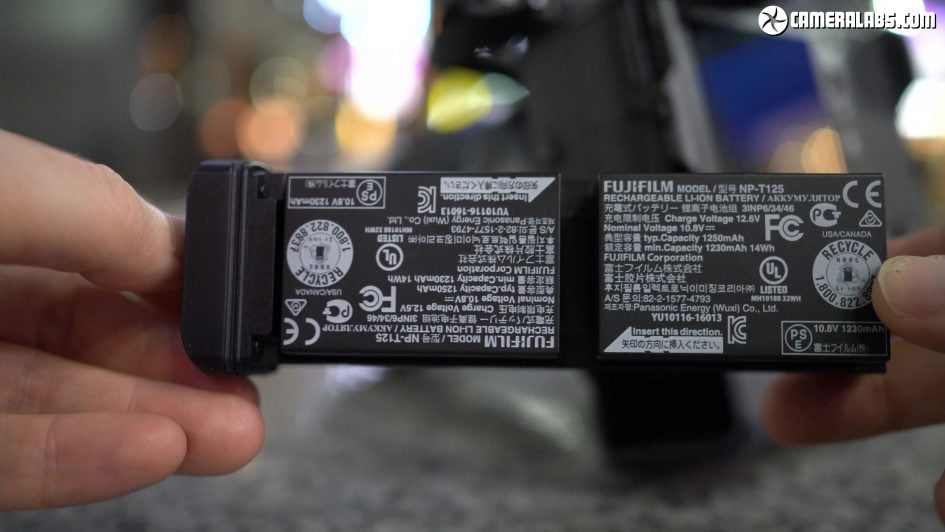
Fujifilm powers the GFX 100 with a pair of NP-T125 batteries – the same used in the GFX 50S and 50R – housed in a tray which slides into the portrait grip. These effectively double the battery life from the 400 shot rating of the previous bodies to 800 shots here. The batteries can be charged in-camera over USB and support rapid charging with sufficient current. During my initial tests with two batteries, I managed around 300 shots with several minutes of video, lots of Bluetooth tagging, and plenty of playback
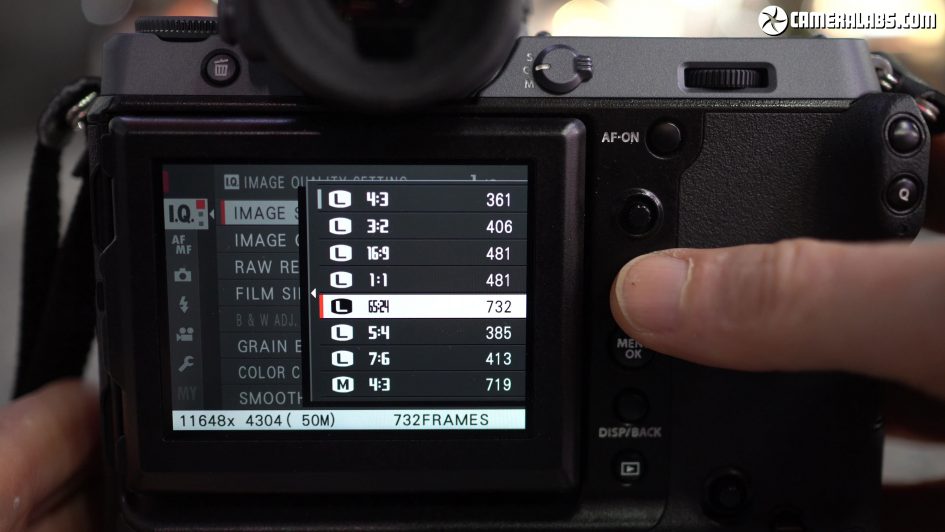
In the absence of cross-keys you’ll be using the joystick to navigate the menus and under the image settings you’ll notice a wealth of aspect ratios including a new 65:24 panoramic option; these all crop the image, but there’s still plenty of pixels to play with. Under image quality you can choose three JPEG compression levels, recorded with or without a RAW file, or of course RAW by itself if preferred. Super fine JPEGs measured between 40 and 60 Megapixels. RAW files can be recorded compressed or uncompressed and in the choice of 14 or 16 bits, although 16 bit slows-down recording and doesn’t allow continuous bursts. You’re looking at about 130MB for a 16-bit compressed RAW file. As a Fujifilm camera, you have the full-array of Film Simulations at your disposal including Eterna for slightly muted but attractive video footage, and ACROS which remains my favourite black and white process; the GFX 100 also inherits the monochrome adjustment, grain effect and colour chrome effect of recent X-bodies. Meanwhile the Smooth Skin option does just that, subtly smoothing skin areas in portraits without losing the biting resolution you want around the eyes. A considerate option with the unforgiving resolving power here.
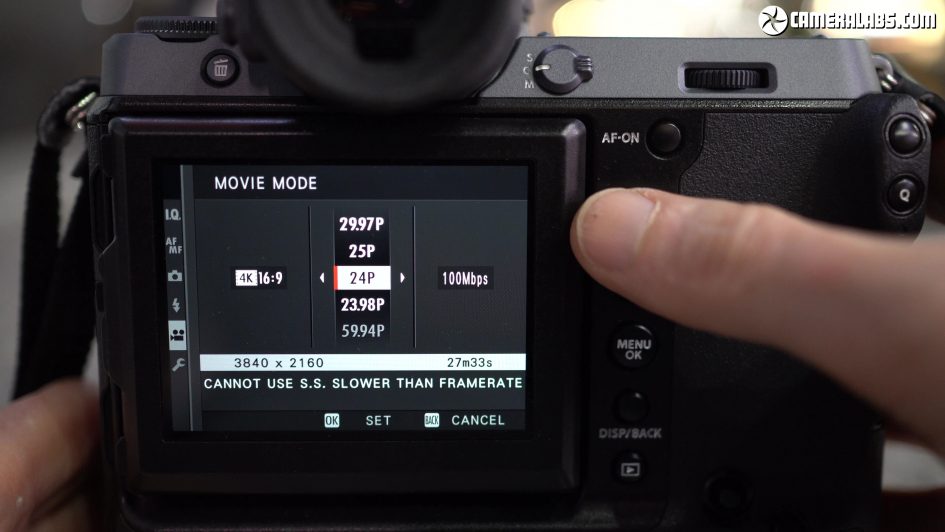
The GFX 100 becomes the first medium format system to capture 4k video using the full sensor width without cropping, up to 30p and in 10 bit 4:2:0 internally or 10 bit 4:2:2 externally over HDMI. You can record 4k clips up to 60 minutes in length. 1080 video up to 60p is also available, although there’s no higher frame rates for slow motion. Like the X-series, you can also choose between 17:9 DCI or 16:9 aspect ratios.
Above: The GFX 100 oversamples 50 Megapixels worth of data to generate a 4k frame, which results in plenty of detail. Since the camera starts with 76 Megapixels when shooting in 16:9, I assume there’s some line-skipping to get to 50, but the results still look very good. Download the original file (Registered members of Vimeo only).
Above: The full range of Film Simulations are available for video and for all my clips in my field test video I used Eterna for slightly muted, natural-looking video out of camera. Download the original file (Registered members of Vimeo only). You can also download my Fujifilm GFX 100 4k F-Log movie sample.
Check prices on the Fujifilm GFX 100 from B&H, Adorama or WEX. Alternatively get yourself a copy of my In Camera book or treat me to a coffee! Thanks!
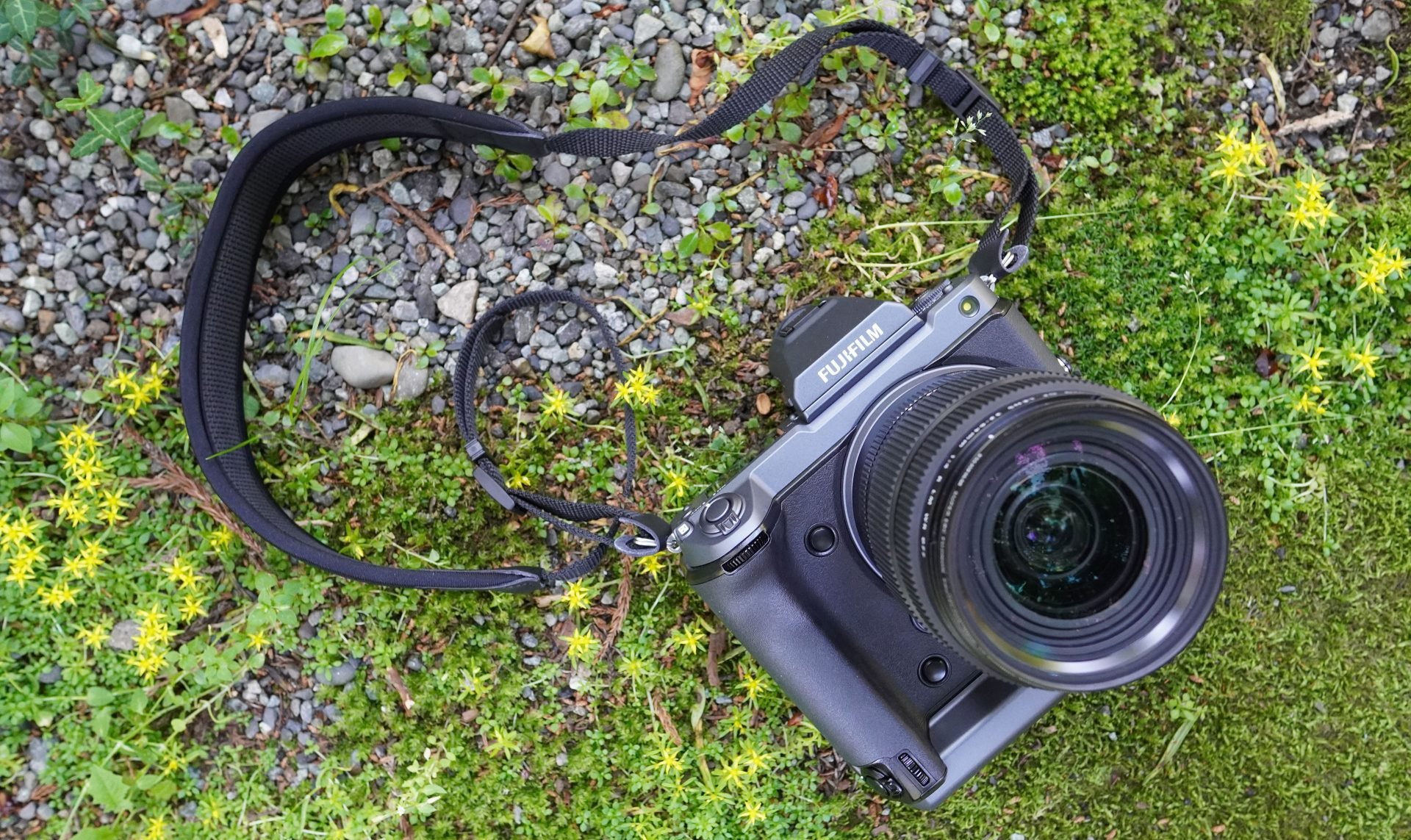
 With the GFX100, Fujifilm’s medium format mirrorless system truly comes of age. The previous GFX 50S and 50R were desirable but their resolution was matched and their overall handling beaten by the best of the full-frame mirrorless cameras. The GFX100 changes all of that. The headline resolution of 102 Megapixels from a back-illuminated sensor delivers a significant step-up in detail without compromising noise or dynamic range, but it’s the combination of built-in stabilisation, phase-detect autofocus, respectable 4k video and the best viewfinder around that transforms the overall experience. Sure there’s a handful of misses: the portrait grip was slimmed to save size and weight, but I’d have sacrificed size for a more consistent experience. I also feel the rear controls are unnecessarily small, there’s surely room for a full-size HDMI port, the viewfinder can block the screen when viewed from above, and the rear sub-monitor really needs a button to cycle through the views. Then there’s the price which while cheap for medium format, remains expensive compared to full-frame. After all you could buy a 40 to 60 Megapixel full-framer for a third of the price and either stitch two images or use a high-res composite mode to come close to the overall detail here. But the GFX100 gives you the convenience of capturing those big files in a single frame and handheld too. Ultimately while the GFX100 is aimed at a specialist market, it redefines what we can expect from a medium format camera, delivering industry-leading quality at the price with surprisingly easy and enjoyable handling more akin to smaller formats.
With the GFX100, Fujifilm’s medium format mirrorless system truly comes of age. The previous GFX 50S and 50R were desirable but their resolution was matched and their overall handling beaten by the best of the full-frame mirrorless cameras. The GFX100 changes all of that. The headline resolution of 102 Megapixels from a back-illuminated sensor delivers a significant step-up in detail without compromising noise or dynamic range, but it’s the combination of built-in stabilisation, phase-detect autofocus, respectable 4k video and the best viewfinder around that transforms the overall experience. Sure there’s a handful of misses: the portrait grip was slimmed to save size and weight, but I’d have sacrificed size for a more consistent experience. I also feel the rear controls are unnecessarily small, there’s surely room for a full-size HDMI port, the viewfinder can block the screen when viewed from above, and the rear sub-monitor really needs a button to cycle through the views. Then there’s the price which while cheap for medium format, remains expensive compared to full-frame. After all you could buy a 40 to 60 Megapixel full-framer for a third of the price and either stitch two images or use a high-res composite mode to come close to the overall detail here. But the GFX100 gives you the convenience of capturing those big files in a single frame and handheld too. Ultimately while the GFX100 is aimed at a specialist market, it redefines what we can expect from a medium format camera, delivering industry-leading quality at the price with surprisingly easy and enjoyable handling more akin to smaller formats.



